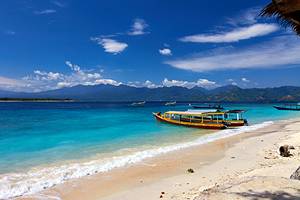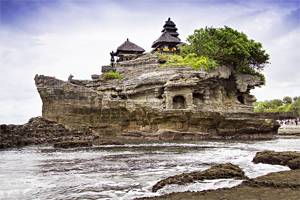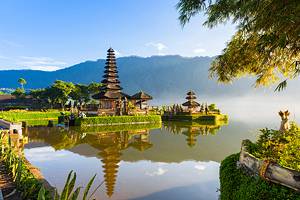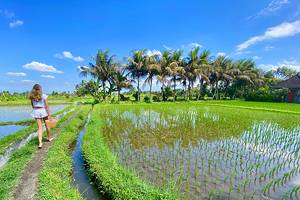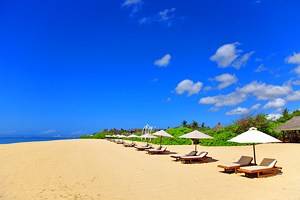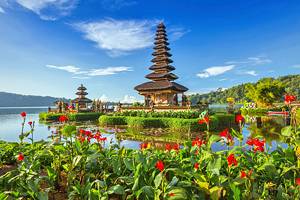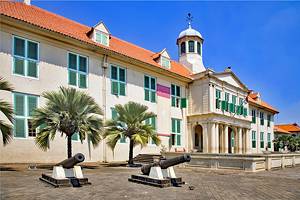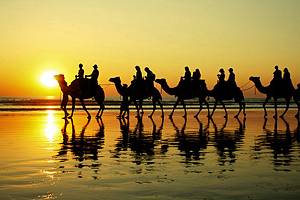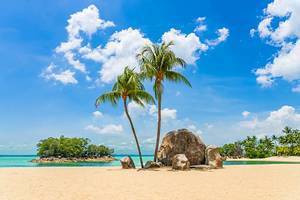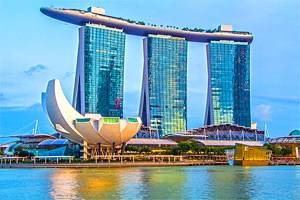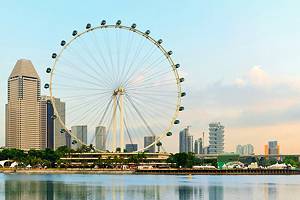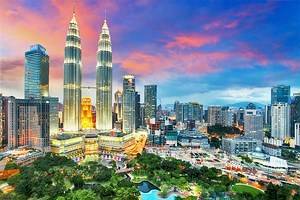Best Time to Visit Bali
Bali is one of the world's most beautiful and captivating destinations. It's a fact: There's never a bad time to visit Bali. But certain months of the year might offer you a better experience than others, based on the seasons and the weather, as well as your budget and preferences.
Most tourists take advantage of Bali's dry season to spend long days in the sun at the beach. However, there are also some compelling benefits to visiting during the rainy season – after all, that's when prices drop; the rice paddies get that dreamy, misty atmosphere; and the waterfalls surge.
Ready to bring your dream of visiting this cherished Indonesian destination to life? Let our guide to the best time to visit Bali help you get the right dates on the calendar.
On This Page:
| Average minimum and maximum temperatures for Bali, Indonesia in °C | |||||||||||
| J | F | M | A | M | J | J | A | S | O | N | D |
| 30 26 | 30 26 | 31 26 | 31 26 | 30 26 | 29 25 | 28 24 | 28 24 | 29 24 | 30 25 | 31 26 | 30 26 |
| PlanetWare.com | |||||||||||
| Average monthly precipitation totals for Bali, Indonesia in mm. | |||||||||||
| 348 | 287 | 213 | 94 | 76 | 71 | 51 | 23 | 41 | 91 | 155 | 292 |
| Average minimum and maximum temperatures for Bali, Indonesia in °F | |||||||||||
| J | F | M | A | M | J | J | A | S | O | N | D |
| 86 78 | 86 78 | 87 78 | 87 78 | 86 78 | 85 77 | 83 76 | 83 76 | 85 76 | 86 77 | 87 78 | 86 78 |
| PlanetWare.com | |||||||||||
| Average monthly precipitation totals for Bali, Indonesia in inches. | |||||||||||
| 14 | 11 | 8.4 | 3.7 | 3.0 | 2.8 | 2.0 | 0.9 | 1.6 | 3.6 | 6.1 | 12 |
Best Time to Go to Bali

The best time to visit Bali is during the island's dry season, which runs from April through October. This weather in Bali during this time of year gives tourists the climate they need to enjoy some of the best beaches in Indonesia, and take part in outdoor adventures, like hiking Mount Batur and cliff jumping.
The average temperature in Bali hovers between 25 and 30 degrees Celsius throughout the year. During the dry season, tourists are treated to beautiful beach weather, with average daily temperatures in the high 20s.
The months of April through October are the least humid time of year in Bali. And while you can expect ample amounts of sunshine during Bali's dry season, don't be surprised if you get the occasional shower. The rain usually won't last all day, though, and it gives the landscape a distinctive tropical lushness. It's a smart idea to pack an umbrella and rain jacket, just in case.
Throngs of tourists from around the world flock to Bali during its dry season to take advantage of the vacation-friendly weather. In typical years, the island receives between 475,000 and 625,000 visitors each month of the dry season. Hotel prices start climbing in April, eventually peaking in August and slowly falling until the holidays in December. Brace yourself for heavy crowds at Bali's top places to visit. You may have to search far and wide to find a beach that isn't packed with people.
The massive influx of tourists also presents another issue you should be aware of: traffic. Road traffic in Indonesia can be notoriously bad, causing even modest journeys to drag on for hours. Try to avoid excessive car travel if you're visiting Bali during the dry season, and if you do need to get around the island, plan your trips outside of rush hour to avoid some of the heaviest traffic. You might also want to bring a few car games to help pass the time on long drives in traffic.
Despite the crowds and traffic, Bali is a wonderful place to travel from April through October. The destination offers tons of sunshine, a gentle breeze, warm azure seawater, and minimal humidity during the dry season. Tourists are also spoiled for choice of events and activities to include on their itinerary, making it well worth the splurge to visit during the peak season if your budget allows for it.
Best Season to Visit Bali

Bali has two separate seasons: wet and dry. The best season to visit Bali is during the dry time of year. It gives tourists plenty of sunny days to explore Bali's incredible coastal hot spots, like Seminyak Beach, Nusa Dua Beach, and Echo Beach, or check out the tropical inland attractions, like the cultural city of Ubud or the beautiful rice paddies in Jatiluwih.
If you're trying to avoid the crowds (and stretch your travel budget), plan your trip during the shoulder of the dry season. This typically means visiting Bali during April, May, September, or October, outside of the traditional school break for the summer. You'll still have pleasant weather during this time, albeit with a slightly higher likelihood of rain. The lower cost of accommodations and activities, and smaller crowds, may make up for the higher risk of showers, though.
Tourists who are visiting during the middle of the dry season (June-August) will come across massive crowds at nearly all the popular attractions around Bali. You can avoid some of the bustle by heading away from the main tourist areas of Kuta, Ubud, Seminyak, and Canggu.
Instead, explore what's off the beaten path in Bali. North Bali is filled with surging waterfalls and rice paddies. The beaches in East Bali, especially around Keramas, tend to be considerably less crowded than those in the south (although they don't have great surf in the dry season). Plus, the drive there takes you through picturesque fields and villages. You could also consider visiting Lake Buyan and Lake Tamblingan, twin lakes in the caldera of an ancient volcano.
Another relatively undiscovered place worth checking out is Nusa Lembongan, a tiny island off Bali's southeast coast. The mellow destination, which is home to many seaweed farmers, has a chilled-out atmosphere, pristine beaches, and epic cliffs with spectacular views. Watch out for the school kids zooming down paths on their motorbikes in the afternoon!

While the dry season is by far the most popular time to visit Bali, the wet season can also be lovely (and much easier on your budget). The average temperature is typically around 27 degrees Celsius in November, December, and January, climbing to 29 to 30 degrees Celsius in February and March. As for precipitation, Bali is wettest between December-February. Expect lots of heat, humidity, and rain if you visit Bali during the wet season – the price you'll pay for getting a bargain at hotels and attractions.
Bad weather doesn't keep all tourists away during the wet season, especially in December, when nearly half a million tourists make their way to Bali for their holiday celebrations. However, the monsoon season is much less crowded and there are still plenty of things to do. Consider visiting one of the island's many yoga studios, taking a Balinese cooking class, sightseeing around Ubud, catching a flick at cinemas in Kuta, or exploring the destination's awesome temples.
The rainy season is not a great time to trek up Mount Batur or explore the rice paddies around Ubud. The trails can get really slippery and leave you covered in mud. However, don't write off outdoor activities completely during the wet season. The rain storms sometimes only last a few hours – if they come at all. You might get lucky and have just enough beach weather to get a tan during the monsoon season in Bali. Play it by ear, and you might be pleasantly surprised with how your trip turns out.
Best Month to Visit Bali

The best month to visit Bali is April, followed by May, September, and October. These are the months on the shoulder of the high season. While the island will still be crowded, it won't be quite as busy (or as expensive) as the peak tourist season of June, July, and August. The weather is sunny and beautiful during these months, with only the occasional rain shower. Plus, there are tons of special events.
The festival season in Bali is in high gear in spring, typically with the Bali Spirit Festival (a celebration of yoga, music, and art held in April or May). There's also the Ubud Food Festival, a multi-day event that showcases the best foods and drinks on the island, which is traditionally held in May (but check local listings for the most up-to-date information).
Looking to take a surf lesson in Bali? April and May bring about great surf to westward facing beaches, like Canggu, Uluwatu, Kuta, and Bingin. With temperatures in Bali climbing as high as 36 degrees Celsius in April, you'll want to cool off in the refreshing sea.
Keep your eye on the calendar if you're planning a trip to Bali around this time of year. Nyepi, the Balinese Day of Silence, which is based on the Balinese calendar, typically occurs in March or April. For 24 hours, the island completely shuts down, and everyone is expected to participate. Lights are dimmed, businesses close, TVs and stereos are muted, and transportation (including the airport) ceases – presenting challenges to tourists.
With that being said, the holiday is a special time in Bali. The days leading up to Nyepi are filled with revelry, like firecrackers, burning effigies of evil spirits, and boisterous parades. Take advantage of the big day to truly relax. Sleep in, enjoy quiet meals at your hotel, pore over a novel, and enjoy the traffic-free soundscape. After all, this is what vacation is really about.
May, September, and October rival April as the best months to visit Bali. They have similar warm, sunny weather. The rate of tourists arriving to the island isn't quite as high as the peak season. And there are tons of fun events and seasonal activities that will take your trip to Bali to the next level.
Throughout the month of May, Bali's Badung regency hosts its Festival Bahari (or "sea festival"). It aims to draw visitors to Bali's south coast through a variety of events, such as traditional boat race competitions, parades, and waterfront activities.
In the fall, Bali showcases its arts and culture at the Pesona Nusa Dua Fiesta. Expect traditional dance recitals, parades, photography competitions, body painting contests, and live music performances all around the luxury beach resort area of Nusa Dua. Look out for the festival in October or November.
Another creative event to check out in the fall is the Ubud Writers & Readers Festival, which usually takes place in late October or early November. Literary lovers from around the world flock to Bali for a multi-day celebration of great books and compelling conversations between authors. The renowned event also offers writing workshops, film screenings, and poetry slams.
Tourists who visit Bali in October or November also have the opportunity to see a riveting cultural event: Makepung Buffalo Races. Farmers hook their buffalo up to traditional wooden plows, then hop atop and race the horned beasts on 500-meter-long rice fields to compete for the fastest time around Jembrana in West Bali. Another quirky aspect of this series of events is the Buffalo fashion shows. Farmers wrap their buffalo in cultural ornaments, crown them with funky headdresses, and drape them with bells in hopes of earning the title of "Best Dressed" in the costume competitions. You'll definitely want to bring your camera.
Rains in early October can make it a great time to visit Bali's famous rice paddies. The lush weather turns the terraced landscapes into an emerald-hued paradise in places like Tegalalang, Jatiluwih, and Munduk. Consider booking a guided tour of the rice paddies to learn more about the traditional agricultural techniques behind these famous natural attractions.
Cheapest Time to Visit Bali

The cheapest time to travel to Bali is during the monsoon season, particularly January, which sees a heavy amount of rain. However, people do still visit at this time and there are things to do.
In some years, one of the most important feasts for Hindus in Bali, Galungan, occurs during the monsoon season. It's based on the 210-day Balinese calendar, so the holiday can sometimes occur twice in the same conventional calendar year. The devout believe that ancestral spirits visit the Earth around the time of Galungan. To prepare, families create beautiful offerings of food and blossoms and bring them to local temples. You'll also see penjor, curved bamboo poles dangling with fruit and flowers, pop up all around Bali, as well as mini altars at residential gates – converting the island into a festive paradise.
Ahead of the event, visit village markets to sample the special holiday cake known as jaja. It'll sweeten your rainy season visit to Bali.
Heavy rains during the monsoon season might make some outdoor activities off limits. Fortunately, Bali offers plenty of things to do indoors. Consider devoting some of the money you saved on hotels and airfare to pampering with a spa treatment at one of the luxurious resorts in Uluwatu, Nusa Dua, or Jimbaran Bay.
You could also flex your body and find some zen in a yoga class in Ubud or Canggu, or learn the Balinese style of silversmithing in a jewelry workshop in Celuk or Mas. By night, head to the Nusa Dua Theatre or Bali Safari Park to see local dancers bring Bali's legends and folklore to life.


